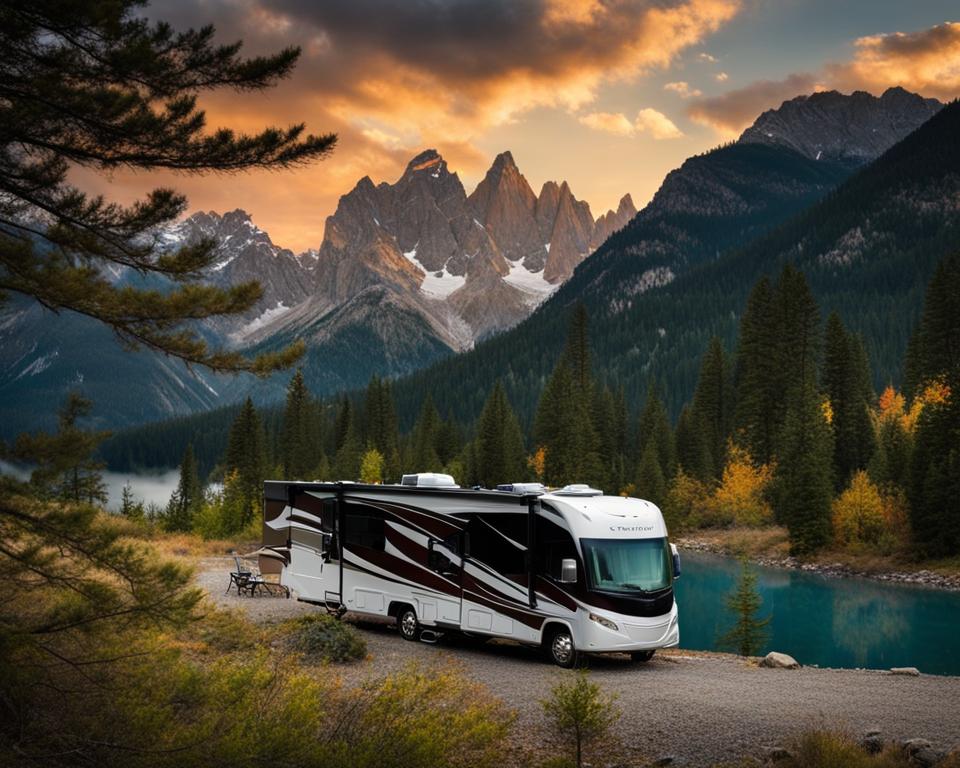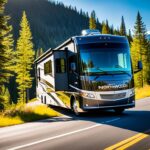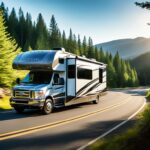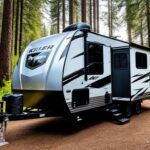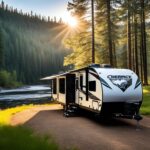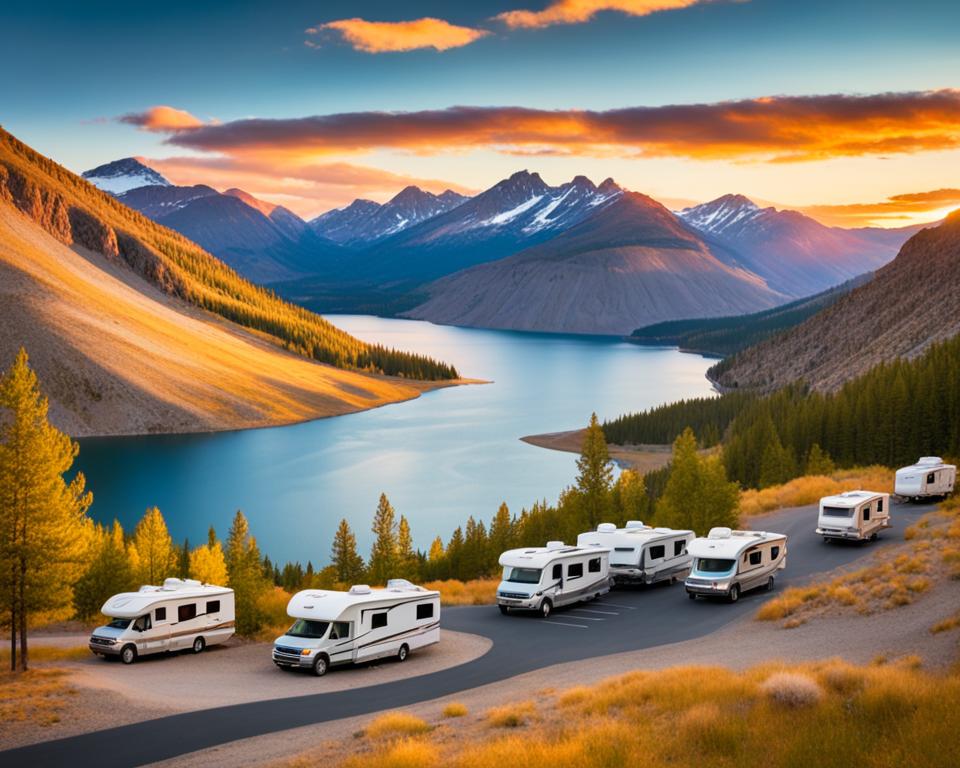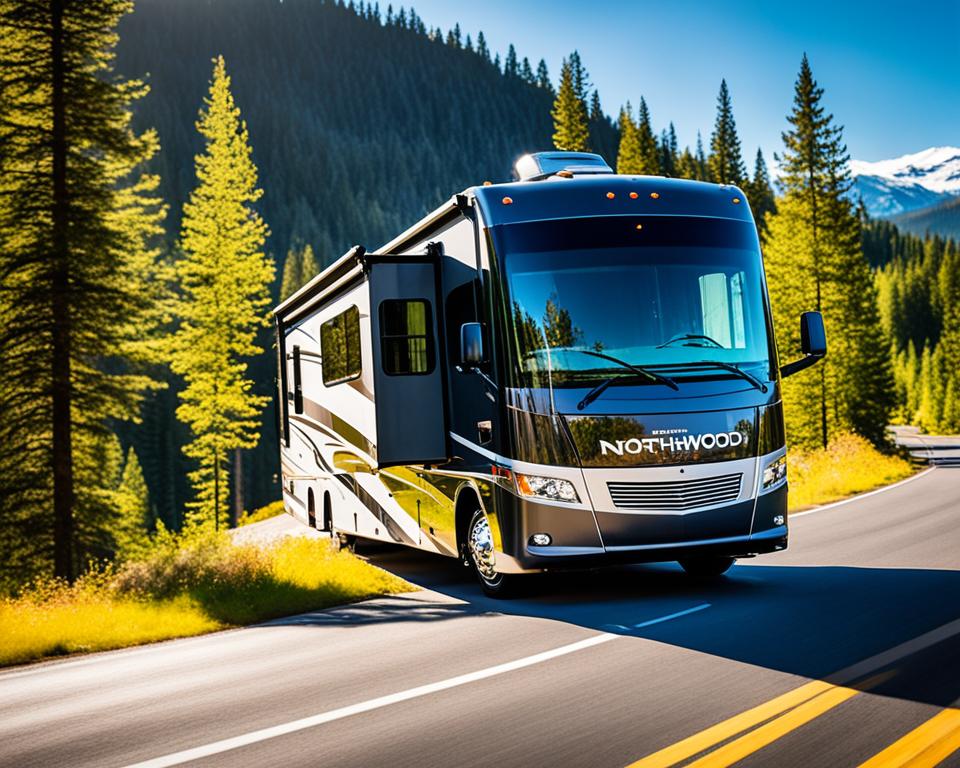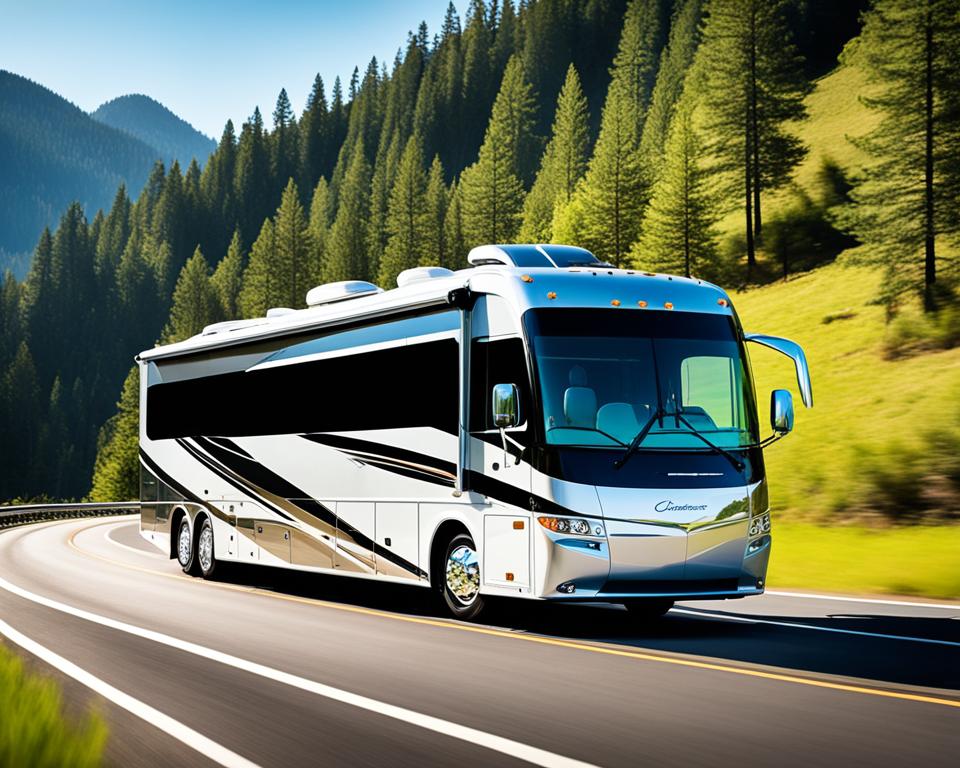A full size recreational vehicle, commonly known as an RV, is a motor vehicle that combines transportation and living quarters for travel, recreation, and camping. It is essentially a home on wheels, equipped with amenities such as sleeping areas, kitchens, bathrooms, and storage spaces. The dimensions and features of a full size RV can vary depending on the specific type and class of the vehicle.
Key Takeaways:
- A full size recreational vehicle, or RV, is a motor vehicle that offers both transportation and living quarters for travel, recreation, and camping.
- An RV is equipped with amenities such as sleeping areas, kitchens, bathrooms, and storage spaces.
- The dimensions and features of an RV can vary based on the specific type and class of the vehicle.
- RVs provide a convenient and comfortable way to travel and explore, offering the freedom of a home on wheels.
- When choosing an RV, it’s essential to consider factors such as length, width, and height to ensure maneuverability and compliance with regulations.
Understanding RV Dimensions: Length, Width, and Height
When it comes to full size recreational vehicles, understanding the dimensions is crucial. The length, width, and height of an RV can greatly impact its maneuverability, towing requirements, and available living space. Different types of full size RVs offer varying dimensions and features to cater to different needs and preferences.
A full size RV is equipped with amenities such as sleeping areas, kitchens, bathrooms, and storage spaces. These vehicles provide the comfort and convenience of a home on wheels, making them ideal for travel, recreation, and camping.
Types of Full Size Recreational Vehicles:
- Class A Motorhomes: These are the largest and most luxurious RVs available. They are typically built on a bus or heavy-duty truck chassis. Class A motorhomes offer spacious living areas, multiple slide-outs for extra room, and a wide range of amenities.
- Class B Motorhomes: Also known as camper vans, Class B motorhomes are smaller and more compact. They are built on a van chassis and offer a good balance between size and convenience. Class B motorhomes are easier to maneuver and have better fuel efficiency compared to Class A motorhomes.
- Class C Motorhomes: Class C motorhomes fall between Class A and B in terms of size and features. They are built on a truck chassis and offer a more affordable option with ample living space. Class C motorhomes often have a sleeping area above the driver’s cab and come equipped with various amenities.
- Travel Trailers: Travel trailers are towable RVs that can be easily hitched to a compatible tow vehicle. They come in various lengths and offer a range of floor plans to accommodate different needs. Travel trailers provide the flexibility of detaching the living space from the towing vehicle.
- Fifth Wheels: Fifth wheels are also towable RVs but require a pickup truck with a specialized hitch in the truck bed. They offer more living space compared to travel trailers and provide additional stability due to their unique design. Fifth wheels are an excellent choice for those seeking a home-like experience on the road.
By understanding the dimensions and features of different types of full size recreational vehicles, you can choose the one that best suits your travel style, comfort needs, and towing capabilities.
When selecting an RV, it’s important to consider the dimensions that will meet your specific requirements. The length, width, and height of the RV can impact its maneuverability and the types of campsites or parking spaces it can comfortably fit into. Additionally, the dimensions may also affect the amount of interior living space available.
“Choosing an RV with dimensions that align with your travel plans and preferences will ensure a smooth and enjoyable journey.”
“RV dimensions can vary across different models and brands, so take the time to research and compare options to find the perfect fit for your adventures.”
Average RV Lengths By Class
When choosing the right full size recreational vehicle (RV), one important factor to consider is its length. The average lengths of RVs can vary based on their class, each offering unique advantages and considerations. Let’s explore the average lengths of different RV classes and how they can impact your RVing experience.
Class A Motorhomes
Class A motorhomes are known for their spaciousness and luxury. These full size motorhomes are built on a bus or heavy-duty truck chassis, offering ample living space and amenities. The length of Class A motorhomes can range from 25 to 45 feet, providing plenty of room for relaxation, entertainment, and comfortable accommodations. With their larger size, Class A motorhomes offer the advantage of more storage space, higher ceilings, and enhanced comfort during extended trips.
Class B Motorhomes
For those looking for a more compact option without compromising on convenience, Class B motorhomes, also known as camper vans, are an excellent choice. These versatile RVs typically measure around 20 feet in length, making them more maneuverable and easier to navigate in urban areas or crowded campgrounds. Class B motorhomes offer the advantages of better fuel efficiency, lower maintenance costs, and the ability to park in regular-sized parking spaces, making them an ideal option for those seeking a smaller, more efficient RV.
Class C Motorhomes
Class C motorhomes strike a balance between Class A and B motorhomes and are a popular choice among RV enthusiasts. With lengths ranging from 20 to 30 feet on average, Class C motorhomes provide a comfortable living space for families and small groups. These motorhomes are built on a cutaway chassis, featuring a distinctive over-the-cab area that provides additional sleeping space or storage. Class C motorhomes offer the advantage of easier maneuverability, better fuel efficiency compared to Class A motorhomes, and the ability to access more campsites with length restrictions.
| RV Class | Average Length |
|---|---|
| Class A Motorhomes | 25-45 feet |
| Class B Motorhomes | ~20 feet |
| Class C Motorhomes | 20-30 feet |
Choosing the right full size RV length depends on your travel preferences, the number of occupants, and the type of campsites you plan to visit. While longer RVs offer more living space, they require more maneuvering considerations and may have restrictions in certain campgrounds. Conversely, smaller RVs provide enhanced maneuverability and accessibility to a wider range of campsites, but may have limited interior space. Consider your specific needs and preferences to find the perfect fit for your RVing adventures.
Width and Height of RVs
When it comes to full size recreational vehicles, it’s important to consider the width and height to ensure a comfortable and convenient experience while camping or traveling. The width of most RVs is around 8’6″, providing ample space for living, dining, and storage areas. However, fifth wheels, known for their spacious interiors, can be slightly wider, ranging from 8 to 10 feet. It’s worth noting that some RVs may have slide-outs that extend the width, reaching up to 14’6″. The added width can offer additional living space, making it ideal for full-size RVs for camping or traveling.
The height of RVs also varies depending on the type and class. Class B motorhomes, which are more compact, typically stand between 7-9 feet tall. On the other hand, fifth wheels tend to measure at approximately 9 feet in height on average. The height of an RV is a crucial factor to consider when planning your trips, especially if you’ll be parking in areas with height restrictions or low clearance. Understanding the width and height of your full size RV ensures safe and hassle-free travel, allowing you to enjoy the full potential of your recreational vehicle.
Class A, B, and C Motorhomes
Full size motorhomes offer a range of options for those seeking the freedom and convenience of a home on wheels. These recreational vehicles (RVs) are divided into three main classes: Class A, Class B, and Class C. Each class has its own unique features and benefits, catering to different travel needs and preferences.
Class A Motorhomes:
Class A motorhomes are the largest and most luxurious of the three classes. These RVs are typically built on a bus or heavy-duty truck frame, providing ample living space and a wide range of amenities. With an average length of 25 to 45 feet, Class A motorhomes offer plenty of room for comfortable living, making them ideal for extended trips and full-time RV living. They are equipped with all the comforts of home, including full kitchens, bathrooms, and sleeping areas. Class A motorhomes are known for their luxurious interiors and high-end finishes, offering a truly upscale RV experience.
Class B Motorhomes:
Class B motorhomes, also known as camper vans, are smaller and more compact compared to Class A motorhomes. They are typically built on a van chassis, offering excellent maneuverability and fuel efficiency. With an average length of around 20 feet, Class B motorhomes are easier to drive and park in urban areas compared to larger RVs. Despite their compact size, Class B motorhomes still provide essential amenities such as sleeping quarters, a small kitchenette, and a bathroom. They are popular among solo travelers, couples, and small families looking for a more nimble and versatile RV option.
Class C Motorhomes:
Class C motorhomes combine the best features of Class A and Class B motorhomes, making them a popular choice for many RV enthusiasts. These RVs are typically built on a van or truck chassis, providing a good balance of size and comfort. With an average length ranging from 20 to 30 feet, Class C motorhomes offer plenty of living space while still maintaining maneuverability on the road. They are often equipped with a sleeping area above the cabin, providing additional sleeping accommodations. Class C motorhomes feature amenities similar to Class A motorhomes, including kitchens, bathrooms, and dining areas. They are a versatile option for families and larger travel groups.
Owning a full size RV provides numerous benefits for travelers. Whether you choose a Class A, Class B, or Class C motorhome, you’ll have the freedom to travel with ease and enjoy the comforts of a home on the road. Full size RVs offer unmatched convenience, allowing you to bring all the amenities and comforts of home with you wherever you go. From fully equipped kitchens for preparing meals to cozy sleeping quarters for restful nights, owning a full size RV ensures that you can enjoy the convenience and comfort of home while exploring new destinations.
“Owning a full size RV provides the freedom to travel with ease and enjoy the comforts of a home on the road.”
Additionally, full size RVs offer the flexibility to choose your own route and schedule. You can take spontaneous detours, stay longer in places that captivate you, and create your own unique travel experiences. The ability to travel at your own pace and on your own terms is truly liberating.
Whether you’re embarking on a weekend getaway, a cross-country adventure, or even a full-time nomadic lifestyle, a full size RV provides the perfect platform for exploration and adventure. With a wide range of options available, from luxurious Class A motorhomes to compact Class B camper vans and versatile Class C motorhomes, finding the right full size RV for your needs is an exciting journey in itself.
Towable RV Dimensions: Travel Trailers and Fifth Wheels
Towable RVs offer another popular option for full-size recreational vehicles, providing flexibility and customization opportunities for camping and traveling enthusiasts. Two commonly chosen towable RV types are travel trailers and fifth wheels, each offering unique features and dimensions to suit different needs and preferences.
Travel Trailers
Travel trailers are available in various sizes and styles, allowing RV owners to select the perfect fit for their camping adventures. From small teardrop trailers to more spacious models, travel trailers cater to a wide range of camping and traveling experiences.
“Travel trailers provide versatility in terms of size and layout, making them ideal for individuals or families looking to embark on camping trips or cross-country adventures,” says John Davis, an experienced RV enthusiast.
Here is a breakdown of typical travel trailer dimensions:
| Travel Trailer Type | Length Range (feet) |
|---|---|
| Teardrop trailers | 10 – 14 |
| Small travel trailers | 16 – 20 |
| Midsize travel trailers | 20 – 25 |
| Large travel trailers | 25 – 40 |
Fifth Wheels
Fifth wheels are another popular choice for full-size RV enthusiasts, offering more living space and stability compared to travel trailers. They require a pickup truck for towing, but their unique design provides additional square footage and a comfortable, home-like feel.
“Fifth wheels are perfect for travelers seeking a spacious and luxurious experience while on the road. Their unique hitch configuration provides improved stability and maneuverability compared to other towable RV options,” mentions Emma Thompson, an experienced RV traveler.
Here is a breakdown of typical fifth wheel dimensions:
| Fifth Wheel Type | Length Range (feet) |
|---|---|
| Standard fifth wheels | 25 – 40 |
| Luxury fifth wheels | 35 – 45 |
Whether you opt for a travel trailer or a fifth wheel, towable RVs provide full-size camping options for those seeking adventure on the road.
RV Dimension Regulations: State and National Parks
When traveling with a full size RV, it is essential to be aware of the dimension regulations imposed by state and national parks. These regulations aim to ensure the safety, accessibility, and preservation of the natural environment within the parks. They may include limits on the length, width, and height of RVs allowed in specific camping areas or park roads.
To enjoy a smooth and enjoyable experience while exploring the beauty of different parks, it is important for RV owners to research and comply with these regulations. By following the guidelines, you can avoid any unnecessary hassles and setbacks during your outdoor adventures.
Owning a full size RV provides the flexibility to visit state and national parks, allowing you to immerse yourself in the breathtaking landscapes, unique flora and fauna, and awe-inspiring surroundings. Whether it’s hiking along scenic trails, fishing in picturesque lakes, or simply enjoying the tranquility of nature, a full size RV gives you the freedom and convenience to fully embrace the benefits of outdoor exploration.
Check out this table below to understand the various dimension regulations imposed by different state and national parks:
| Park | Length Limit (feet) | Width Limit (feet) | Height Limit (feet) |
|---|---|---|---|
| Yellowstone National Park | 30-50 | 8’6″ | 12’6″ |
| Grand Canyon National Park | 35-40 | 8’6″ | 12’6″ |
| Yosemite National Park | 35-40 | 8’6″ | 12’6″ |
| Great Smoky Mountains National Park | 35-40 | 8’6″ | 12’6″ |
Remember to always check the specific regulations of the state and national parks you plan to visit. Be prepared and respectful of these guidelines to ensure a memorable and enjoyable experience while preserving the natural wonders for future generations to enjoy.
Measuring Your RV and RV Storage Considerations
Properly measuring your full size RV is essential when considering buying a full size recreational vehicle and exploring the benefits of owning a full size RV. Taking accurate measurements helps you comply with regulations, select suitable storage options, and ensure a proper fit in parking spaces and garages.
When measuring the length of your RV, start from the front bumper and measure all the way to the rear bumper. This measurement is crucial for determining if your RV meets the length requirements imposed by various parks and campgrounds. It also helps you assess parking availability and towing capabilities.
The height of your RV is another important dimension to consider. Measure from the ground to the highest point on the RV, including any rooftop accessories or add-ons. Understanding the height of your RV ensures you can safely pass under bridges, navigate through tunnels, and avoid obstructions along your journey.
Note: Don’t forget to measure any accessories or add-ons that may affect the overall dimensions of your RV.
RV storage is a crucial consideration for full size RV owners. The size of available garages and parking spots should be taken into account when choosing your RV and planning for storage options. Larger RVs require more space and may require specialized off-site storage rentals, while smaller RVs can often fit into standard storage facilities or residential garages.
Here is a table summarizing the important dimensions to measure when considering a full size RV:
| Dimension | Description |
|---|---|
| Length | Measures the distance from the front bumper to the rear bumper of the RV |
| Height | Measures the distance from the ground to the highest point on the RV, including any rooftop accessories or add-ons |
By measuring your RV accurately and considering RV storage options, you can ensure a seamless travel experience and maximize the benefits of owning a full size recreational vehicle.
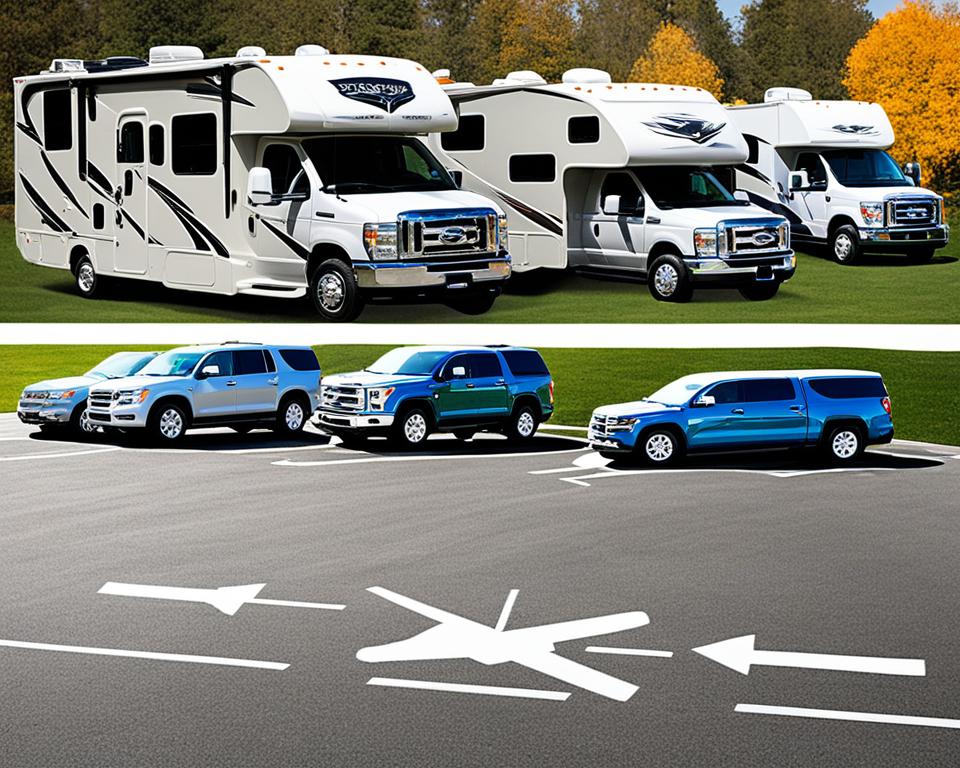
Conclusion
Full size recreational vehicles offer a thrilling and convenient way to travel, camp, and explore. With a wide range of types and classes available, there is a full size RV to suit every need and preference. Whether you desire the luxury of a Class A motorhome, the compactness of a Class B camper van, or the versatility of a travel trailer, owning a full size RV allows you to experience the freedom and comfort of a home on wheels.
When choosing the right full size RV, it is important to consider various factors such as dimensions, features, and regulations. Understanding the length, width, and height of different RV types will help you make an informed decision that aligns with your travel goals and preferences. Additionally, always be mindful of state and national park regulations to ensure a seamless and enjoyable exploration of nature’s beauty.
By owning a full size RV, you can reap the benefits of having a mobile home. Enjoy the convenience of having your living quarters and amenities on board, allowing you to travel at your own pace and create unforgettable memories. Whether you’re embarking on a cross-country road trip, seeking adventure in the great outdoors, or simply looking for a comfortable way to travel, a full size RV is the perfect companion.
So, start your full size RV journey today! Consider the dimensions, features, and regulations when choosing the right full size RV, and embrace the freedom of the open road. With a full size recreational vehicle, your next adventure awaits!
FAQ
What is a full size recreational vehicle?
A full size recreational vehicle, commonly known as an RV, is a motor vehicle that combines transportation and living quarters for travel, recreation, and camping. It is essentially a home on wheels, equipped with amenities such as sleeping areas, kitchens, bathrooms, and storage spaces.
What are the dimensions of a full size RV?
The dimensions of a full size RV can vary depending on the specific type and class of the vehicle. The length of an RV can range from 20 to 45 feet, while the width is usually around 8’6″ and the height varies from 7 to 9 feet.
What are the different types of full size recreational vehicles?
There are three main classes of full size motorhomes: Class A, Class B, and Class C. Additionally, there are towable RVs such as travel trailers and fifth wheels. Each type offers different dimensions, features, and benefits.
How do I choose the right full size RV for me?
When choosing the right full size RV, consider factors such as your travel needs, preferences, and the dimensions of the vehicle. Class A motorhomes are the largest and most luxurious, while Class B motorhomes are more compact. Class C motorhomes offer a balance between the two. Travel trailers and fifth wheels provide flexibility and customization options.
Can I use a full size RV for camping?
Yes, full size RVs are commonly used for camping. They provide a convenient and comfortable way to enjoy the outdoors while having access to amenities such as sleeping areas, kitchens, and bathrooms.
Can I use a full size RV for traveling?
Absolutely! Full size RVs are designed for travel. Whether you’re taking a road trip or exploring new destinations, owning a full size RV allows you to travel with ease and enjoy the comforts of a home on wheels.
What are the benefits of owning a full size RV?
Owning a full size RV provides the freedom to travel at your own pace, enjoy the comforts of home while on the road, and have the flexibility to camp in various locations. It also allows you to create memorable experiences and explore new destinations with ease.
Are there regulations on RV dimensions in state and national parks?
Yes, different parks may have regulations on the length, width, and height of RVs allowed within their premises. It is important to research and comply with these regulations to ensure a smooth and enjoyable camping or traveling experience.
How do I measure my full size RV and consider storage options?
To measure your full size RV, start from the front bumper and measure to the rear bumper for length. For height, measure from the ground to the highest point on the RV. Also, consider accessories and add-ons that may affect the overall dimensions. When it comes to storage, consider the size of available garages and parking spots, as larger RVs require more space and may necessitate specialized off-site storage rentals.

